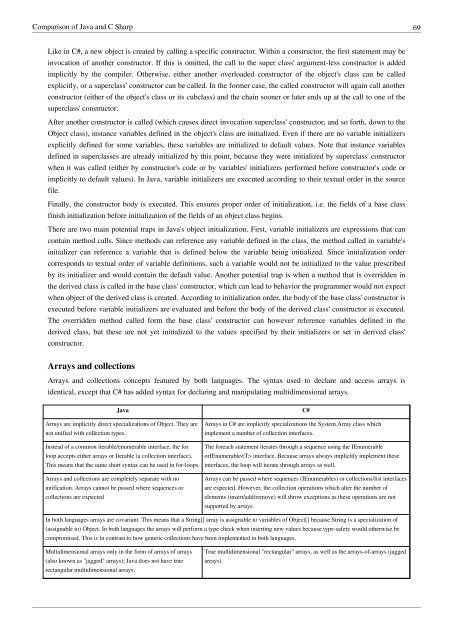Contents - Cultural View
Contents - Cultural View
Contents - Cultural View
Create successful ePaper yourself
Turn your PDF publications into a flip-book with our unique Google optimized e-Paper software.
Comparison of Java and C Sharp 69<br />
Like in C#, a new object is created by calling a specific constructor. Within a constructor, the first statement may be<br />
invocation of another constructor. If this is omitted, the call to the super class' argument-less constructor is added<br />
implicitly by the compiler. Otherwise, either another overloaded constructor of the object's class can be called<br />
explicitly, or a superclass' constructor can be called. In the former case, the called constructor will again call another<br />
constructor (either of the object's class or its cubclass) and the chain sooner or later ends up at the call to one of the<br />
superclass' constructor.<br />
After another constructor is called (which causes direct invocation superclass' constructor, and so forth, down to the<br />
Object class), instance variables defined in the object's class are initialized. Even if there are no variable initializers<br />
explicitly defined for some variables, these variables are initialized to default values. Note that instance variables<br />
defined in superclasses are already initialized by this point, because they were initialized by superclass' constructor<br />
when it was called (either by constructor's code or by variables' initializers performed before constructor's code or<br />
implicitly to default values). In Java, variable initializers are executed according to their textual order in the source<br />
file.<br />
Finally, the constructor body is executed. This ensures proper order of initialization, i.e. the fields of a base class<br />
finish initialization before initialization of the fields of an object class begins.<br />
There are two main potential traps in Java's object initialization. First, variable initializers are expressions that can<br />
contain method calls. Since methods can reference any variable defined in the class, the method called in variable's<br />
initializer can reference a variable that is defined below the variable being initialized. Since initialization order<br />
corresponds to textual order of variable definitions, such a variable would not be initialized to the value prescribed<br />
by its initializer and would contain the default value. Another potential trap is when a method that is overridden in<br />
the derived class is called in the base class' constructor, which can lead to behavior the programmer would not expect<br />
when object of the derived class is created. According to initialization order, the body of the base class' constructor is<br />
executed before variable initializers are evaluated and before the body of the derived class' constructor is executed.<br />
The overridden method called form the base class' constructor can however reference variables defined in the<br />
derived class, but these are not yet initialized to the values specified by their initializers or set in derived class'<br />
constructor.<br />
Arrays and collections<br />
Arrays and collections concepts featured by both languages. The syntax used to declare and access arrays is<br />
identical, except that C# has added syntax for declaring and manipulating multidimensional arrays.<br />
Java C#<br />
Arrays are implicitly direct specializations of Object. They are<br />
not unified with collection types.<br />
Instead of a common iterable/enumerable interface, the for<br />
loop accepts either arrays or Iterable (a collection interface).<br />
This means that the same short syntax can be used in for-loops.<br />
Arrays and collections are completely separate with no<br />
unification. Arrays cannot be passed where sequences or<br />
collections are expected<br />
Arrays in C# are implicitly specializations the System.Array class which<br />
implement a number of collection interfaces.<br />
The foreach statement iterates through a sequence using the IEnumerable<br />
orIEnumerable interface. Because arrays always implicitly implement these<br />
interfaces, the loop will iterate through arrays as well.<br />
Arrays can be passed where sequences (IEnumerables) or collections/list interfaces<br />
are expected. However, the collection operations which alter the number of<br />
elements (insert/add/remove) will throw exceptions as these operations are not<br />
supported by arrays.<br />
In both languages arrays are covariant. This means that a String[] array is assignable to variables of Object[] because String is a specialization of<br />
(assignable to) Object. In both languages the arrays will perform a type check when inserting new values because type-safety would otherwise be<br />
compromised. This is in contrast to how generic collections have been implemented in both languages.<br />
Multidimensional arrays only in the form of arrays of arrays<br />
(also known as "jagged" arrays); Java does not have true<br />
rectangular multidimensional arrays.<br />
True multidimensional "rectangular" arrays, as well as the arrays-of-arrays (jagged<br />
arrays).










